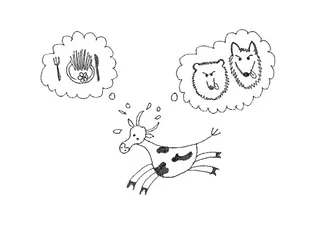Work package 1A - Cattle-carnivore encounters: Behaviour and stress 1A - Risk factors for depredation on free-ranging cattle

In Norway, the depredation rate on cattle is about 100 times lower than that one for sheep. Therefore, cattle has been suggested as a suitable alternative to sheep in carnivore-exposed areas. We want to identify risk factors for large carnivore depredation on cattle. Even more, we want to describe the success factors of herds with zero or low number of losses within the wolf zone.
Work package 1B - Cattle-carnivore encounters: Behaviour and stress

Understanding the mechanisms and consequences of cattle-carnivore encounters will help to evaluate practical and ethical aspects of cattle ranging on forested outfield pastures. We study how cattle space use, grazing activity and animal welfare is affected by carnivore encounters. To what extent space use and habitat selection of freeranging cattle and carnivores are overlapping is crucial to predict risky habitats. We therefore also monitor carnivore movement behaviour in relation to forested outfield cattle pastures.
We collaborate with farmers to monitor their herds with Nofence collars. These collars have movement sensor that measure neck movement ten times per second. We have now developed a model that classifies the sensor data into different behaviours. The results are published as scientific article and as a more informative comic, check out our blog post.


